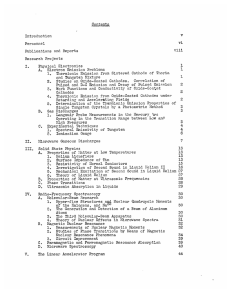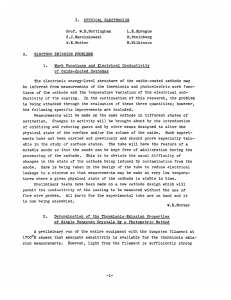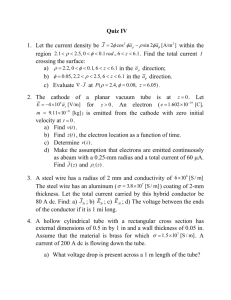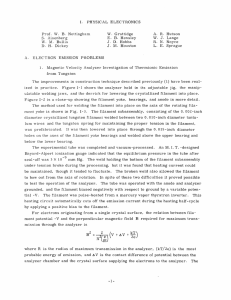__~L ~ ^.^.----~II- I.^L._LI~--..-~.
advertisement
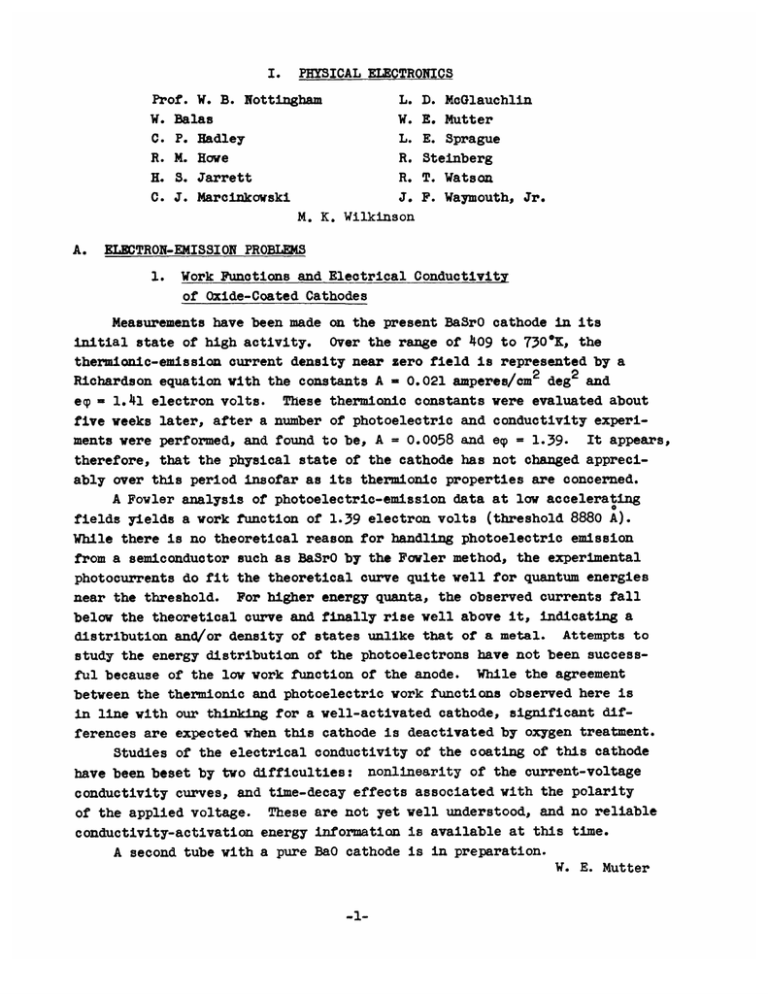
~___ __~L I.^L._LI~--..-~. ~^.^.----~II- ---~I-il I. Prof. W. B. Nottingham W. Balas L. D. McGlauchlin W. E. Mutter C. P. Hadley L. E. Sprague R. M. Howe R. Steinberg H. R. T. Watson S. Jarrett C. J. Marcinkowski A. PHYSICAL ELECTRONICS J. F. Waymouth, Jr. M. K. Wilkinson ELECTRON-EMISSION PROBLEMS 1. Work Functions and Electrical Conductivity of Oxide-Coated Cathodes Measurements have been made on the present BaSrO cathode in its initial state of high activity. Over the range of 409 to 730*K, the thermionic-emission current density near zero field is represented by a Richardson equation with the constants A = 0.021 amperes/cm2 deg 2 and e(p = 1.41 electron volts. These thermionic constants were evaluated about five weeks later, after a number of photoelectric and conductivity experiIt appears, ments were performed, and found to be, A = 0.0058 and ep = 1.39. therefore, that the physical state of the cathode has not changed appreciably over this period insofar as its thermionic properties are concerned. A Fowler analysis of photoelectric-emission data at low accelerating fields yields a work function of 1.39 electron volts (threshold 8880 A). While there is no theoretical reason for handling photoelectric emission from a semiconductor such as BaSrO by the Fowler method, the experimental photocurrents do fit the theoretical curve quite well for quantum energies near the threshold. For higher energy quanta, the observed currents fall below the theoretical curve and finally rise well above it, indicating a distribution and/or density of states unlike that of a metal. Attempts to study the energy distribution of the photoelectrons have not been successful because of the low work function of the anode. While the agreement between the thermionic and photoelectric work functions observed here is in line with our thinking for a well-activated cathode, significant differences are expected when this cathode is deactivated by oxygen treatment. Studies of the electrical conductivity of the coating of this cathode have been beset by two difficulties: nonlinearity of the current-voltage conductivity curves, and time-decay effects associated with the polarity of the applied voltage. These are not yet well understood, and no reliable conductivity-activation energy information is available at this time. A second tube with a pure BaO cathode is in preparation. W. E. Mutter -1- -C- Cli ^~I- ~Yrll_-.lllll 1___.._ -I~I---1-I L.-II--L .- (I. --^I^X._~^-1_I~_----_____L 1-II~-_ ..I~L_ I_ ^I-.1._.LI -l--l-Il(_ I---^ -~ I- ^11-.^--~-1I.-I_-I-~--^----.-~ ~LI1_^_1~_-. _..141111-~-1~1 .. PHYSICAL ELECTRONICS) 2. Determination of the Thermionic-Emission Properties of Single Tungsten Crystals by a Photometric Method Electron-emission patterns have been observed photometrically on a new cylindrical type of projection tube in which the inside surface of the coaxial cylindrical glass envelope was coated one-fourth of the way around with phosphor and three-fourths of the way around with a conducting coating of Aquadag. Although the emission pattern observed with this tube showed considerably better contrast (and therefore indicated that interference due to scattered light was greatly reduced by this tube design), it was not possible to eliminate it entirely. The difficulty of outgassing the Aquadag coating sufficiently, so that filament contamination was totally eliminated, made it impossible to get measurements of sufficient reliability for the determination of the thermionic constants under investigation. C. J. Marcinkowski 3. Determination of the Field-Emission Properties of Single Tungsten Crystals by a Photometric Method Progress has been made in the construction of the necessary auxiliary equipment to create the sharp single-crystal tungsten points needed for the study, and to process the tubes under exceptionally favorable vacuum conditions. A suitable power supply has been constructed and it is now anticipated that preliminary results will be obtained soon. M. K. Wilkinson 4. Energy Distribution of Electrons from Ultrafine-Grain Oxide Cathodes In general, studies of the thermionic emission from oxide-coated cathodes have been done either with indirectly heated cathodes or with wires heated by passing current through them during the time of observation. In order to study the emission properties near zero field, it is necessary to use either indirect heating or pulse-current heating. In the latter case, observations are made during the "off" part of each cycle. A square-wave pulser is available and may be operated to give on-off periods of 2 milliseconds each. In this research, the oxide coating is to be deposited by a cataphoretic process. For the initial studies, the base metal will be crystallized tungsten polished smooth and heat-treated to give large single crystals. One of the objectives of the study will be to determine whether or not the crystallographic structure of the base metal influences the emission of the oxide-coated cathode. A "projection" tube made by depositing a phosphor on the inside surface of a coaxial cylindrical envelope will be used for -2- (I. PHYSICAL ELECTRONICS) the qualitative determination of the influence of the crystal structure of the base metal. Some of the objectives of this investigation will include an attempt to separate out the so-called patch effects, reflection effects and the effect of excess slope usually found when "Schottky" plots are made at C. P. Hadley high accelerating fields. 5. Investigation of Certain Properties of Oxide-Coated Cathodes Using Radioactive-Tracer Techniques A research program is now planned for the near future on the use of radioactive tracers to investigate certain properties of oxide-coated cathodes. This study involves many problems not hitherto investigated at this Laboratory; a clear statement of our immediate objectives will be R. T. Watson described in the October Quarterly Report. Studies of the Phenomenon of Standby Deterioration of Oxide-Coated Cathodes During the past two years, users of vacuum tubes for high-speed computer installations have been particularly disturbed by the deterioration in tube operability when standard vacuum tubes containing oxide-coated cathodes stand by with the cathodes hot but with the electron-emission current cut off. Although tube failure in these circumstances is a very common occurrence, specially prepared groups of tubes having electrical characteristics similar to those that fail, and operated in a similar manner, have been produced and found to suffer no appreciable deterioration during some thousands of hours of standby operation. With this fact in mind, it is evident that the discovery and the elimination of the factors which thus interfere with tube operation will be of considerable interest for both theoretical and practical considerations. This investigation is being carried on cooperatively with the Whirlwind Project and with the J. F. Waymouth, Jr. cathode research group of the Raytheon Company. 6. 7. Studies of Photoelectric Emission The investigation of the photoelectric-emission properties of solid surfaces is of interest from many points of view. For such studies to have the scientific validity to make them useful for better understanding of the fundamental physical phenomena involved, superior vacuum conditions must be maintained. The long-term program, as it is now being set up, involves studies of both pure metals and semiconductors that might be of H. S. Jarrett interest. -3- __~II_~~ 1~ _L~II_______ JX ^_li_ ~*__~__I____ CIXII1I_~ -~yll~-) ili l^ ~---il-l~i~---~-_l_-i-*tii (I. B. I IIPI. -III-C --._ I~C IP1-PLIII~ L~Llh PHYSICAL ELECTRONICS) STUDIES WITH GASEOUS DISCHARGE 1. Hot-Cathode Arc in Cesium Vapor The work has been completed and Technical Report No. 128 is being prepared for publication. A second tube has been constructed. Instead of a fixed probe and movable anode and cathode, this second tube contained a series of probes along the length of the tube for measurement of plasma potential and other properties as a function of distance along the length of the arc. The anode and cathode were fixed in position. The results obtained from this tube were essentially the same as those obtained from the first tube; these were reported in the Progress Report of April 15, 1949. The potential was found to be a linear function of distance to within 0.5 cm from the anode and cathode at all vapor pressures and are currents for which data were taken. Various possible mechanisms by which ions could be produced in the are were investigated. Even when the total voltage across the are was less than the ionization potential of cesium (3.87 volts), no potential "humps" were found in the arc, i.e., no two points in the arc could be found with a static potential difference as great as the ionization potential, so that it does not seem possible that electrons were able to gain sufficient energy for ionization by simply falling through a potential difference. Data were taken only at those vapor pressures and are currents for which no low-frequency oscillations were found (see April 15, 1949, Progress Report). Under these conditions, no oscillations could be detected with instruments which were believed sensitive up to 10,000 Mc. This result, together with the fact that only meager evidence to the contrary could be found in the literature, indicates that the supply of ions was not dependent on the existence of oscillations. The results of calculations showed that, if it is assumed that the electrons in the plasma have a Maxwellian velocity distribution corresponding to a temperature indicated by probe measurements, the number of electrons with energies greater than the ionization energy was not sufficient to produce ions as fast as they were lost to walls. Electron temperatures from 2300*K to 3500 0 K were indicated. When the phenomenon of imprisonment of resonance radiation, and the fact that the probability of ionization for excited atoms may be several times the probability of ionization for atoms in the ground state, were considered, it appeared, after rough calculations were made, that ioniza- - 4-.. (I. PHYSICAL ELECTRONICS) tion by successive collisions was a possible mechanism by which the arc was maintained. This result was obtained in spite of the fact that the lifetimes of the excited states are only about 10-8 seconds. R. K. Steinberg 2. Investigation of Low-Pressure Mercury Arcs Research in the field of low-pressure gas discharges has not been very active in recent years, except in very limited regions largely dictated by practical industrial needs. For this reason, many fundamental problems concerning processes of ionization and excitation are to be reinvestigated, using techniques and results of other fundamental studies not available at the time Langmuir and others developed much of the basic theory in this R. M. Howe field. C. EXPERIMENTAL TECHNIQUES 1. Spectral Emissivity of Tungsten and Tantalum Preliminary results have been obtained for the spectral emissivity of tantalum. Within the accuracy of the measurements, the emissivity is found to vary linearly with the temperature and linearly with the wavelength over the ranges of these variables investigated. The following empirical equation, therefore, serves as a means of expressing the spectral emissivity as a function of wavelength and temperature: E = 0.5935 - 4.5 x 10-5N - (3 x 10-6 + 10-7X)T In the above equation, E is the spectral emissivity, N is the wavelength expressed in millimicrons and T is the absolute temperature in degrees K. The range in temperature over which this equation is thought to hold is 1900*K to 2400K, and the wavelength range is 450 millimicrons to 700 milliIn view of the importance of having available results of unquestionable reliability, an additional determination of the experimental data will be made. The case of tantalum will be considered before the study is microns. extended to include new data for tungsten and possibly new data for molybW. B. Nottingham, L. Sprague, W. Balas, L. D. McGlauchlin denum. 2. Ionization Gauge and High-Vacuum Studies The ionization gauge design now being investigated is the one most commonly used in high-vacuum studies. A hairpin filament serves as a source of electrons and these are collected on a spiral filament surrounding the electron emitter. These filaments are tungsten, capable of being heated to a very high temperature for outgassing purposes. -5- The ion collector -II~ LLYI ~~1~--i_( -L~_-_l l._.Il-~i._LL ._.__I--~_ I__1_____~_I_^XII_ ^i_ ~~ II~XI~-I~IYI1__PI~li _I L-I-..--L_1_..__(.^-~-- (I. PHYSICAL ELECTRONICS) is a tantalum cylinder about 3 cm in diameter and 3 cm long. In addition, the gauge contains an auxiliary filament used in connection with the "flash filament" method of vacuum evaluation. Six gauges of essentially similar construction have been examined for their voltage-current characteristics under the conditions of the best attainable vacuum and also with a gas pressure of inert gas, such as helium or nitrogen at a pressure of approximately 10" mm. The voltage-current characteristics for these two cases are so completely dissimilar that it is possible to show conclusively that when the a parent gas pressure under the best vacuum conditions is of the order of 10- mm, the currents observed in the ion-collector circuit are due almost entirely to the photoelectric emission associated with the absorption of soft x-rays generated at the electron-collector filament when the electrons are absorbed there. The indications are, therefore, that vacua of 10-9 , or even much better, are attainable in a suitably designed and operated vacuum system. W. B. Nottingham, L. Sprague ** -6-

